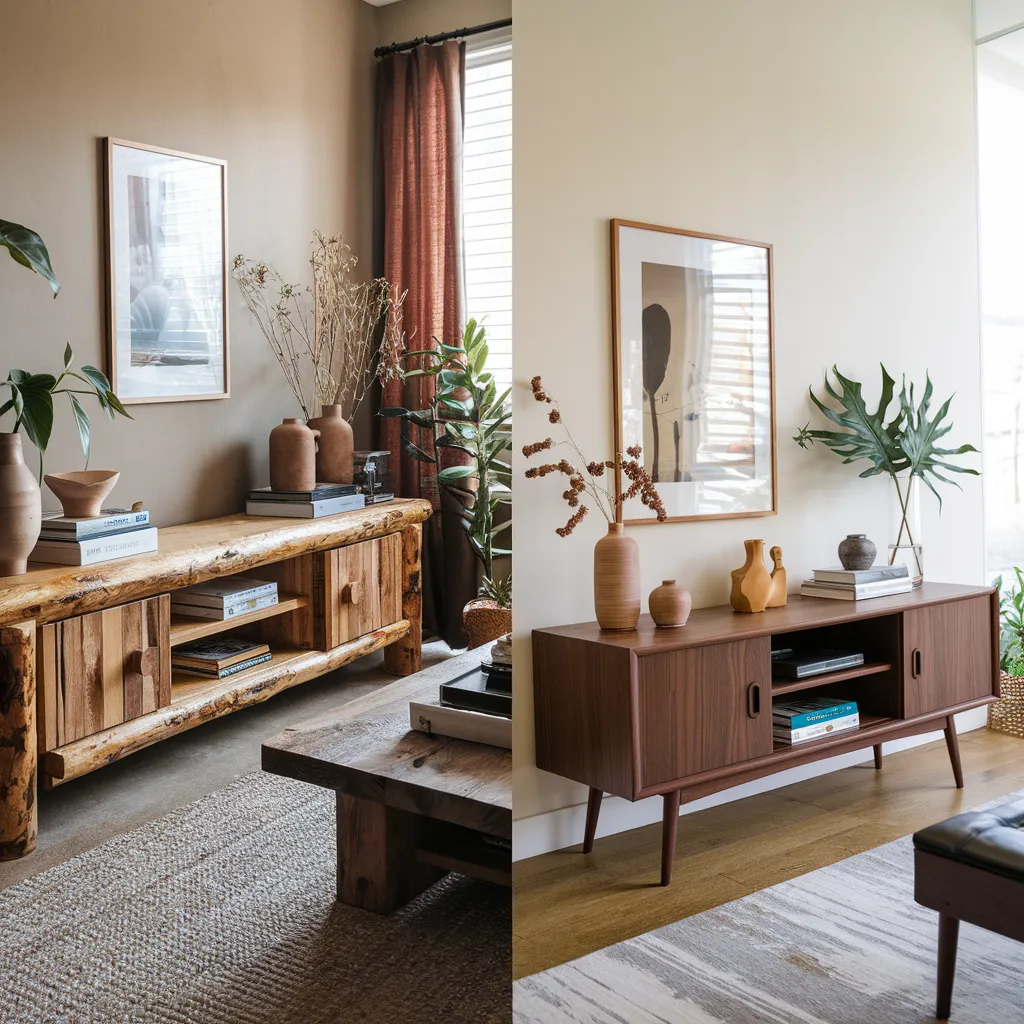TV Stands And Entertainment Units
Rustic vs Mid-Century TV Stands: Which Style Fits Your Home?
TV stands shape the look and feel of the living room. Rustic and mid-century are two of the most popular styles. This article compares them to help you decide which matches your space. For a broader overview, see the pillar guide on choosing wooden TV stands.
Defining rustic TV stands
Rustic TV stands emphasize natural grain, visible knots, and sturdy proportions. They often feature reclaimed wood, distressed finishes, and earthy tones that create a warm, inviting atmosphere. The appeal lies in their character and how imperfections enhance authenticity. Explore available designs in the TV stands collection for rustic options.
Defining mid-century TV stands
Mid-century designs lean toward clean lines, tapered legs, and subtle details. Walnut finishes, smooth edges and low profiles give these stands a sleek yet timeless character. They work well in both minimalist and eclectic interiors.
Comparing structure and function
Rustic builds
Rustic TV stands are often heavier, with thick boards and substantial frames. They bring a grounded presence to the living room and pair naturally with stone fireplaces, textured rugs, and leather seating.
Mid-century builds
Mid-century stands prioritize lighter frames and elevated legs. This creates a sense of openness, especially helpful in smaller rooms. Cable ports and sliding doors are common, blending utility with elegance.
Styling rustic and mid-century stands
Rustic pieces style well with woven baskets, pottery, or vintage décor. Their robust character supports bold accessories. Mid-century stands, by contrast, shine with geometric lamps, framed art, and simple vases. Each style sets a distinct tone. For additional styling tips, visit Console Table Inspiration.
Materials and finishes
Rustic stands often use reclaimed wood, heavy oak, or pine with hand-finished surfaces. Mid-century stands typically feature walnut, teak, or ash with smooth veneers and polished finishes. Consider the existing palette of your room before deciding.
Matching with other furniture
Rustic TV stands align naturally with farmhouse coffee tables or solid wood storage. Mid-century stands integrate seamlessly with slim-legged sofas and minimalist lighting. A consistent tone across furniture ensures a cohesive design language. Complementary pieces include coffee tables and cabinets and chests in matching finishes.
Room size and layout considerations
Rustic designs can dominate small rooms if proportions are not managed, while mid-century stands lighten the visual load thanks to slimmer frames. In larger rooms, rustic stands provide balance and grounding. Consider how traffic flows through your living space before deciding.
Long-term value
Both rustic and mid-century stands crafted from solid wood provide lasting value. Rustic stands offer heritage appeal while mid-century designs remain iconic for their enduring popularity. Investing in quality construction ensures long service life. Learn more about durability in the solid wood TV stands article.
Which style fits your home?
- Choose rustic if you want warmth, texture, and a natural look with strong presence.
- Choose mid-century if you prefer sleek, elevated lines and timeless simplicity.
Your choice depends on room size, current décor, and lifestyle. Both offer character and function but create different moods for the same living space.
Conclusion: rustic or mid-century?
Rustic TV stands deliver organic warmth while mid-century designs bring sleek elegance. Each style has lasting value when crafted from solid wood. Consider your space, décor, and long-term needs. For more living room furniture ideas, explore Coffee Table Design Tips or practical storage solutions in Wooden Cabinets and Chest Guides. To discover all product categories, visit the homepage.

